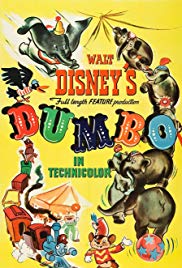Dumbo Premier
Listen to the Recess! Clip
| Author | John Cech |
| Air Date | 10/23/2000 |

Dumbo Premier Transcript
Brief sound clip
That’s the voice of Sterling Holloway (who later would play Winnie-the-Pooh) here as the stork who’s delivering a big bundle of joy to Mrs. Jumbo on the circus train. Today’s the birthday of Walt Disney’s “Dumbo” which had its premier in 1941. Along with “Snow White,” “Pinocchio,” and “Fantasia,” this is one of Disney’s masterpieces — a film so beautifully drawn and realized, despite the fact that it was completed during the famous strike at the Disney studios that cost them some of their best animators, that it truly can’t be compared aesthetically to the sharp-elbowed animation of all the films that would follow. Robin Field, an artist and art historian whose The Art of Walt Disney was the first book-length study of Disney’s genius, all but lived at the studio during these remarkable early days. Field told me years later that he was still astonished by the level of talent that Disney had assembled for these four films. “It was something like being in Florence during the Renaissance,” he said, “the Disney artists were that good.”
So it isn’t surprising that “Dumbo” would be a source of visual inspiration for a number of artists who would later do their own books for children, among them Bill Peet and Partin Provenson, who both worked on the film, and Dr. Seuss, who didn’t but who could have drawn the “Pink Elephants on Parade” sequence — with its surreal forms and wild colors.
“Dumbo” is one of those unique fables of the American experience, one of our primary “Ugly Duckling” stories. It’s about the good-hearted, innocent newcomer who endures ridicule and ostracism and who manages — with a little help from a plucky friend, Timothy J. Mouse, and some magic from a group of good-hearted crows (who know something about psychology) — to turn what seems to be a handicap into a triumph. It’s one of our culture’s basic myths — believe in yourself, don’t give up, and one fine day you’ll be famous and flying.
“Dumbo” is not, however, without its controversies, which is why it’s treated more gingerly that the other Disney milestones. There is the problem of the racial stereotyping of the crows, though they are sympathetic characters and, in the scheme of the movie, they’re among Dumbo’s real friends and helpers. And there is the problem of Dumbo’s ears, a physical deformity that some believe the Disney folks have glossed over. But take a look at the movie and judge for yourself, to see if it turns the corner on these limitations, and, in fact, keeps the promise of all fantasies: to find solutions what’s most important is the assurance of the fantasy and its consolation.